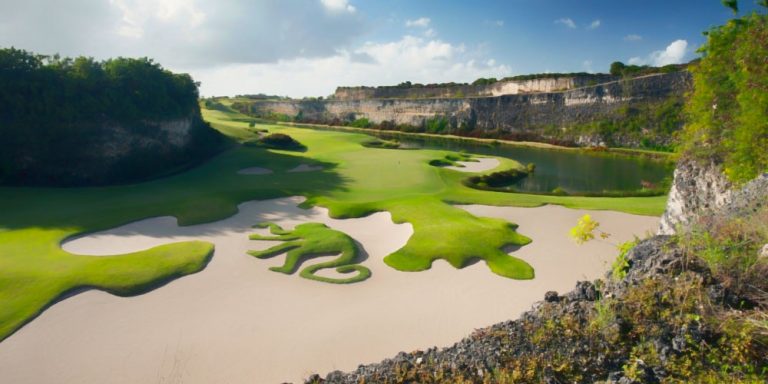What Is A Links Golf Course?

Golf has said to have been born on a links golf course, a term you might have heard many times if you follow golf at all. So what exactly is a “Links Course”? The exact definition is hard to pinpoint as it includes many different factors but in general it is a golf course built on the coastland with deep bunkers and very thick, tall seaside grass. This style of golf course is in fact the oldest style and was said to have been born in Scotland where most “true” link courses reside.
The coastland was generally looked upon as useless to farmers back in the day because of the undulating topography and land that was mostly inhospitable to vegetation. Since the land was not in use two Scotts, as the story goes, decided to hit a ball with a stick on it and golf and links courses were born.
What Makes It A Links Course?
It is said in the book by Malcolm Campbell and George Peper, True Links, that only 246 courses in the world meet the definition of a “true” links course and only four in the United States. The rest are “link-style” courses and this is where you will get many arguments by the pundits over which golf courses are true links course and which are not.
- The course is built along the sea or built along the coastline.
- The course contains many deep bunker hazards and the soil is sandy in nature. The bunkers must be deep due to the wind conditions near the sea that would blow the sand everywhere if not built deep down. Most of the bunkers are in fact sand dunes that were built naturally by nature.
- That brings us to wind, links courses have very windy conditions. The wind can vary from extreme too mild depending on which hole you are on.
- True links course contain no trees at all hence why the wind can get so extreme as there is nothing to deflect the wind’s power. They also should contain very little water hazards if any at all.
- The rough tends to be extremely thick and is not the typical rough you would see on North American PGA courses. It is very tall and wispy in nature.
- The layout of the holes lead you outward to the farthest point away from the clubhouse on the front 9 and then the back 9 lead you back in towards the clubhouse. This gives the golfer the challenge of playing in wind conditions that will be in two opposite directions on both the front and back hole.
- The greens tend to be free of any front hazards. This gives you the opportunity to run the ball up the fairway as an approach shot or putt from the fairway if need be.

Playing Strategies For Links Courses
As you can see these courses are extremely challenging and allows you to use as much creativity as you can think of to get the ball up and down for par. Most PGA Tour players have a total different play style or game plan when playing on links courses in Europe as opposed to when they play regular courses in North America. Some strategies that can help you conquer a links course are:
- Hit your drivers on a lower trajectory. Better yet leave the driver in the bag and use a driving iron or 2 iron. The wind can be so vicious that you do not want your ball floating in the air only to be taking out of bounds by the wind. Hit low, powerful stingers and let the ball run down the fairway.
- Learn how to bump and run. This may be the biggest difference you see when watching a major like the British Open compared to the US Open. Because the fairways lead right up to the greens with no hazards in front of them, it is common to hit a little bump and run shot and let the ball roll up to green as opposed to a pitching wedge lob shot. The greens are extremely hard on links courses so it’s hard to get the ball to stop on a dime with lob shots.
- Putting from the fairway. Almost unheard of on regular golf courses, a common site to see is someone using their putter from 80 yards back on the fairway. Once again because the fairways and greens are fast and hard it is much easier to putt the ball and get it close from a far distance as opposed to attempting a chip shot.
- Be prepared for dramatic weather changes. Because the coastal climate is so unpredictable the weather can dramatically change from hour to hour. You can go from wearing a raincoat or jacket to a tee-shirt in the matter of a few holes.
Famous Links Golf Courses
The Old Course at St. Andrews
The most famous and well known links course has to be the Old Course at St. Andrews. It is the oldest course in the world (established in 1552) and most consider it the “Home of Golf”. It has hosted the Open Championship (or British Open) 29 times dating all the way back to 1873. The best part of St. Andrews is that it is a public course so we all can all hope to have an opportunity to play this legendary course one day.

Carnoustie Golf Links
Located in Scotland Carnoustie is among the rotation of links courses that hosts the Open Championship every 8 years or so. Carnoustie actually has 4 courses but the Championship course is the most famous of the three. It has earned the nickname “Car-Nasty” because of the difficulty to play here and when the weather is not on your side this course is downright treacherous. This links course is truly won of golf’s greatest tests and to win the Open here is especially significant.
Royal Birkdale Golf Club
Established in 1889, Royal Birkdale is located in Southport Engalnd and has hosted the Open 10 times so far. It has a very distinctive art deco clubhouse that you won’t find on any other links course around the world.

Whistling Straits
One of the few links style courses in the United States, Whistling Straits is located in Wisconsin and opened in 1998. There are two courses located here but the Straits Course is the more famous link course. It has hosted the PGA Championship 3 times and is set to host the Ryder Cup in 2020 or 2021. This is not a true links course but the goal was to replicate seaside courses found in Ireland and the UK. It runs along Lake Michigan and contains deep pot-bunkers, few trees and drastic wind conditions.






